
Shakabpa passport
President Roosevelt’s two envoys to Tibet in 1942 were presented their passports at Yatung. [45] The Americans Lowell Thomas Jr. and Sr. visited Tibet in 1949, and were issued “Tibetan passports” at Dromo. “When the Dalai Lama’s passport was spread out before us, I could not help thinking that many Western explorers who had failed to reach Lhasa would have highly prized a document like this.” [46]
Since 1912 passports were also issued to Tibetans leaving for foreign countries. [47] The first modern Tibetan passport [48] with personal information, photograph and space for visas and endorsements was issued in 1948 to members of the Tibetan trade mission. It was modeled on the international one-page fold-out model of 1915. Britain, the USA and seven other countries issued visas and transit visas for this document.
TREATIES

Treaty Pillar of 821-22 AD
One of the most important treaties between the Tibetan Empire and the Chinese Empire (concluded after a decisive Tibetan military victory) dates back to AD 821-822. The text, in Tibetan and Chinese was engraved on three stone pillars (doring). The only surviving pillar is near the Jokhang temple in Lhasa. [49] One clause affirms that between the two nations “…the very world ‘enemy’ shall not be spoken”.
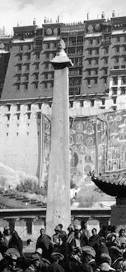
Shol Doring
Another article regarding the frontier (near the present Gansu-Shaanxi border) makes clear that “All to the East is the country of Great China; and all to the West is, without question, the country of Great Tibet.” [50]
This treaty pillar is sometimes mistaken for the more eye-catching Shol doring before the Potala Palace, on which is inscribed the record of another great Tibetan victory, the capture of the Tang Imperial capital of Changan in 763 AD.
As an independent nation, Tibet entered into treaties with neighboring states: Bushair 1681, Ladakh 1683 and 1842, Nepal 1856 and so on.
Tibet signed a number of treaties and conventions with Britain culminating in the Simla Treaty of 1914 by which British India and Tibet reached an agreement on their common frontier. [51] India ’s present-day claims to the demarcation of its northern border (the McMahon Line) is based on this treaty which was signed by independent Tibet – not China.
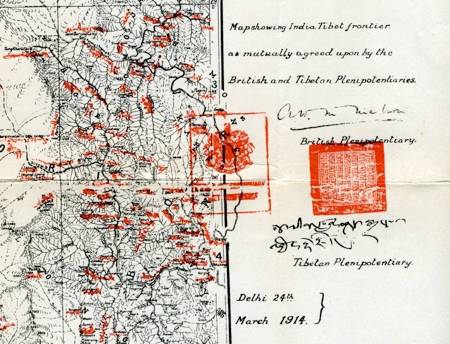
In January 1913, Tibet and Mongolia signed a treaty in Urga, the preamble of which reads: “Whereas Mongolia and Tibet having freed themselves from the Manchu dynasty and separated themselves from China, have become independent states, and whereas the two States have always professed one and the same religion, and to the end that their ancient mutual friendships may be strengthened…” [52] Declarations of friendship, mutual aid, Buddhist fraternity, and mutual trade etc., follow in the various articles. The Tibetan word “rangzen” is used throughout to mean “independence”.
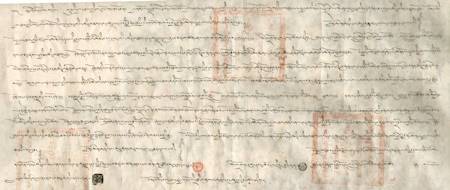
Mongolian Tibet Treaty of 1913
FOREIGN RELATIONS
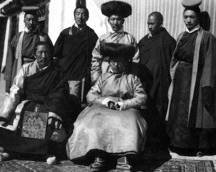
Foreign Bureau personnel
A Bureau of Foreign Affairs was established in 1909 [53] after the 13th Dalai Lama returned to Lhasa from Peking, and the Tibetan people, in symbolic rejection of Manchu rule, presented him with a new national seal. [54] The Foreign Bureau appears to have been reconstituted in 1941. [55] It conducted diplomatic relations with Britain, USA, Nepal, independent India and China. Nepal set up its legation in Lhasa in 1856, China in 1934 and Britain in 1936. Foreign ministry officials represented Tibet as an independent nation in the Inter-Asian Relations Conference convened in India March 23, 1947 to assess the status of Asia in the period following WWII. Tibet was also represented at the Afro-Asian Conference in 1948. Many participating nations were yet to be decolonized making Tibet one of the few established independent nations in that early pan-Asian gathering. [56]
A letter from the Foreign Bureau dated 2nd Nov 1949, to “Mr. Mautsetung”, describes Tibet as a religious nation, independent from “earliest times”, and requests the Communist leader to “issue strict orders” to his officers not to cross into Tibetan territory. Regarding Tibetan territory earlier annexed by China the letter states that “…the Tibetan government would like to open negotiations after the settlement of the Chinese Civil War.” [57]

Foreign Bureau letter to Mao Tsetung
NEUTRALITY IN WORLD WAR II
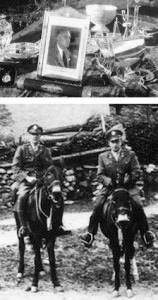
President Roosevelt’s envoys and gifts (above) to the Dalai Lama
Tibet was a declared neutral country (bharnas gyalkhap) during WWII. The Tibetan government successfully resisted pressure from Britain, a threat of invasion from China, and even the personal request of President Roosevelt [58] to allow construction of a military road through Tibetan territory, or allow the passage of military supplies. In a humanitarian gesture, passage of non-military goods was later permitted. Tibet granted political asylum to two Austrian climbers [59] who escaped from a British POW camp in India. It also provided hospitality and transport to American flyers whose plane crashed in Tibet in 1944. [60]
[45] Thomas, Lowell Jr. Out of This World: Across the Himalayas to Forbidden Tibet . New York: The Greystone Press, 1950. pg 79-80. (Facsimile of passport and photograph of Lowell Thomas receiving his passport at Yatung.)
[46] Bell, Charles. Portrait of a Dalai Lama: The Life and Times of the Great Thirteenth. Boston: Wisdom Publications, 1987. p 420. (Bell mentions that a passport was issued to Diwan Bahadur Phala who visited England in 1925.)
[48] Richardson, Hugh. High Peaks Pure Earth: Collected Writings on Tibetan History & Culture. London: Serindia Publications, 1998. Plate 10. (Photograph of Treaty Pillar of AD 821-822 within protective enclosure.)
[49] Richardson, H.E. Tibet and Its History. London: Oxford University Press, 1962. 244-245
[50] The Sino-Indian Boundary Question (Enlarged Edition). Peking: Foreign Language Press,1962. Photostat of eastern sector of original map of the McMahon line with signatures and seals of Tibetan and British plenipotentiaries, Delhi 24 March 1914. Original scale 1:5000,000.
[51] Facsimile of the Tibet-Mongolia Treaty of 1913. Translation in
Richardson, H.E. Tibet and Its History. London: Oxford University Press, 1962. 265-267.
[53] Shakabpa, Tsepon W.D. Tibet:A Political History. Yale University Press, 1967. Frontispiece.
[54] Neushar, Thupten Tharpa. bhod shung tse yiktsang dang chegyal las khung. (The “Peak” Secretariate and the Foreign Bureau of the Tibetan Government). Oral History Series No: 5, Library of Tibetan Works & Archives, Dharamshala, 1998. Neushar states that the Foreign Bureau was set up during the Taktra Regency in the iron serpent year (1941). The office was located south-west of the Tsuglagkhang, and headed by Dsazak Surkhang (zurpa) Wangchen Tseten, and Ta Lama Kunchok Jungnas. Shakabpa in his History claims that the Foreign Bureau was created around 1913.
[55] On 23 March 1947 the Inter-Asian Relations Conference was convened in India to assess the status of Asia in the period following WWII. At this gathering, Tibet was represented as an independent nation, as evidenced by the country’s delineation on a conference map and the first appearance of the Tibetans’ national flag. The Chinese (Guomindang) were furious and protested formally to the organizers of the conference. The Tibetan flag was hoisted and also a flag emblem displayed before the delegates on the dias. Mahatma Gandhi addressed this conference. The representatives of the Tibetan foreign bureau, Theiji Sampo Tenzin Thondup, Khenchung Lobsang Wangyal and Kyibug Wangdue Norbu (translator) also took part in the Afro-Asian Conference held in Delhi in 1948. Interestingly, many of the participants were yet to be decolonized making Tibet one of the few established independent nations at this early pan-Asian gathering.
(Photograph of conference)
[57] Tolstoy, Lt.Col. Ilia. “Across Tibet From India To China ”. The National Geographic Magazine. Washington, D.C.: National Geographic Society, August 1946.
[58] Harrer, Heinrich. Seven Years in Tibet . London: Rupert Hart Davis,1953.
Brauen, Martin. Peter Aufschnaiter’s Eight Years in Tibet. Bangkok: Orchid Press, 2002.